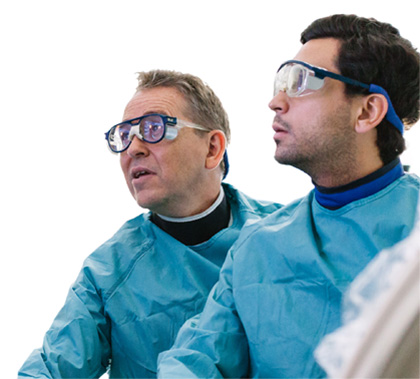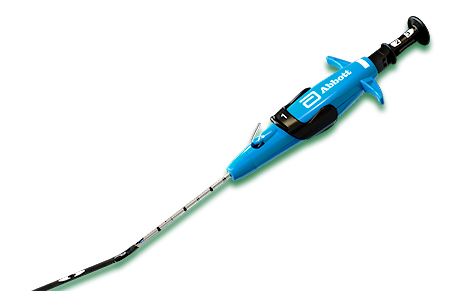In-Person Courses maximize hands-on time to help improve skills and address clinical, technical, and procedural challenges in care. Looking for our Coronary in-person courses? Find them here.
Discover more and download the course catalog for a comprehensive list of our medical education programs.
These courses are designed for Interventional Cardiologists, Vascular Surgeons, and Interventional Radiologists who want to practice complex treatment plans, procedures, and skills to improve their mastery of crucial aspects of patient care.
The focus of this course is on the diagnosis and treatment of complex endovascular lesions and understanding clinical practices that will facilitate consistent, high-quality therapy delivery for patients with Peripheral Artery Disease (PAD), venous disease, SFA disease, and more.
The multi-disciplinary Faculty use a practical, case-based approach to endovascular interventions to enhance the attendee's understanding of evaluating vascular access for a variety of interventions and formulating treatment algorithms that can be used in everyday practice.
Hands-on workshops cover guide wires, Supera™ Peripheral Stent deployment, mechanical thrombectomy, vessel closure, and cadaveric SFA/peroneal, tibial, and pedal access.
Designed For: Interventional Cardiologists, Vascular Surgeons, and Interventional Radiologists looking to improve skills and increase the complexity of the disease they are treating.
2.5 days
Our Specialty Courses offer deeper dives on specific topics with a focus on improving patient outcomes by addressing specific clinical, technical and procedural challenges in endovascular care.
This course offers didactic algorithm training with participant discussion, case-based learning and hands-on workshops that focus on the tools to tackle clinical challenges and to review the indications for use of Abbott’s carotid products in today’s environment.
Completion of this course will satisfy the training requirement for Abbott’s carotid stent systems. Please speak with your Abbott representative post-course about your 3 supervised cases to complete the training process. Completion of this course will satisfy the first steps of the FDA required product training for Abbott’s carotid products.

A specialized training opportunity limited to 1-2 trainees (and no more than 4) with a faculty proctor. Clinical areas of focus can include: Endovascular treatment of SFA/popliteal disease, carotid artery stenting, and vessel closure techniques. Virtual sessions available.

These courses may cover didactic topics such as safe femoral arterial, venous and alternative access techniques / potential complications. Workshops may include ultrasound and hands-on deployment of vascular closure devices.
Workshops at this program that are related to Abbott’s vessel closure products do not satisfy the device training requirements.

MAT-2102232 v5.0

Indications
The Supera™ Peripheral Stent System is indicated to improve luminal diameter in the treatment of patients with symptomatic de novo or restenotic native lesions or occlusions of the superficial femoral artery (SFA) and / or proximal popliteal artery with reference vessel diameters of 4.0 to 7.5 mm, and lesion lengths up to 140 mm.
Contraindications
The Supera™ Peripheral Stent System is contraindicated in:
Warnings
Precautions
The Supera™ Peripheral Stent System should only be used by physicians and medical personnel trained in vascular interventional techniques and trained on the use of this device.
Magnetic Resonance Imaging (MRI) Safety Information
Nonclinical testing has demonstrated that the Supera™ stent, in single and in overlapped configurations up to 250 mm in length, is MR Conditional. A patient with this device can be safely scanned in an MR system meeting the following conditions:
Under the scan conditions defined above, the Supera™ stent is expected to produce a maximum temperature rise of 7.6 °C after 15 minutes of continuous scanning.
In nonclinical testing, the image artifact caused by the device extends approximately 2 cm from the Supera™ stent when imaged with a gradient echo or spin echo sequence and a 3T MRI system.
Potential Adverse Events
Potential adverse events include, but are not limited to:
MAT-2103597 v3.0

Indications:
The Perclose™ ProStyle™ Suture-Mediated Closure and Repair System is indicated for the percutaneous delivery of suture for closing the common femoral artery and vein access sites of patients who have undergone diagnostic or interventional catheterization procedures.
The Perclose™ ProStyle™ SMCR System is indicated for closing the common femoral vein in single or multiple access sites per limb.
The Perclose™ ProStyle™ SMCR System is used without or, if required, with adjunctive manual compression.
For access sites in the common femoral artery using 5F to 21F sheaths. For arterial sheath sizes greater than 8F, at least two devices and the pre-close technique are required.
For access sites in the common femoral vein using 5F to 24F sheaths. For venous sheath sizes greater than 14F, at least two devices and the pre-close technique are required.
Caution:
Federal law restricts this medical device to sale by or on the order of a physician (or allied healthcare professionals, authorized by, or under the direction of, such physicians) who is trained in diagnostic and / or interventional catheterization procedures and who has been trained by an authorized representative of Abbott.
Prior to use, the operator must review the Instructions for Use and be familiar with the deployment techniques associated with the use of this device.
During closure of access sites using a procedural sheath greater than 8F, it is recommended that a vascular surgeon or a surgeon with vascular training be available in case surgical conversion to control bleeding and to repair the vessel is needed.
Contraindications:
There are no known contraindications to the use of this device.
Warnings:
Do not use the Perclose™ ProStyle™ SMCR System if the packaging or sterile barrier has been previously opened or damaged or if the components appear to be damaged or defective.
DO NOT RESTERILIZE OR REUSE. The Perclose™ ProStyle™ SMCR System is intended for single use only.
Do not use the Perclose™ ProStyle™ SMCR System if the sterile field has been broken where bacterial contamination of the sheath or surrounding tissues may have occurred, since such a broken sterile field may result in infection.
Do not use the Perclose™ ProStyle™ SMCR System if the puncture site is located above the most inferior border of the inferior epigastric artery (IEA) and / or above the inguinal ligament based upon bony landmarks, since such a puncture site may result in a retroperitoneal hematoma. Perform a femoral angiogram to verify the location of the puncture site. Note: This may require both a right anterior oblique (RAO) and left anterior oblique (LAO) angiogram to adequately visualize where the sheath enters the femoral vessel.
Do not use the Perclose™ ProStyle™ SMCR System in arterial or venous access if the puncture is through the posterior wall or if there are multiple punctures in the same access site, since such punctures may result in a hematoma or retroperitoneal bleed.
Do not use the Perclose™ ProStyle™ SMCR System if the puncture site is located in the superficial femoral artery or the profunda femoris artery, or the bifurcation of these vessels, since such puncture sites may result in a pseudoaneurysm, intimal dissection, or an acute vessel closure (thrombosis of small artery lumen). Perform a femoral angiogram to verify the location of the puncture site. Note: This may require both a right anterior oblique (RAO) and left anterior oblique (LAO) angiogram to adequately visualize where the sheath enters the femoral vessel.
Precautions:
Potential Adverse Events:
Potential adverse events associated with use of vessel closure devices may include, but are not limited to, the following:
MAT-2100368 v4.0
Stay Connected